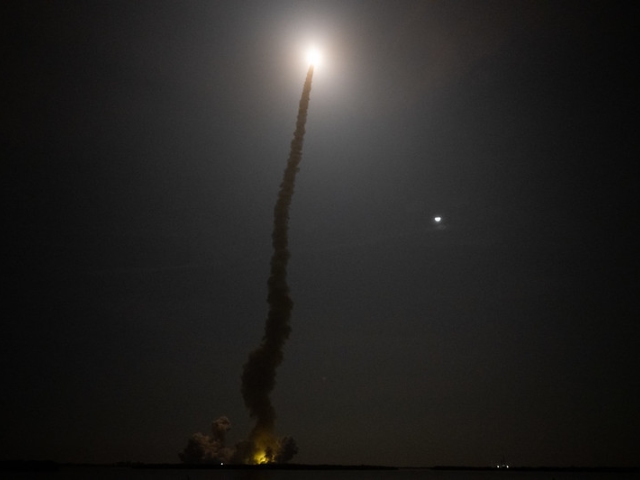
-
Highlights From NASA’s Launch Of The Most Powerful Rocket Ever [Videos]
17 Nov 2022 by Tayla in Lifestyle, Science, Space, Tech/Sci, Video, World
[imagesource: Twitter / NASA Marshall]
NASA tried to launch its 5,75-million-pound Space Launch System (SLS) on August 29 and September 3 this year, only to be thoroughly disappointed.
But the third time was the charm for the space agency.
With a faulty sensor issue and a hydrogen leak out of the way, NASA’s Artemis 1 mission is officially underway.
The SLS lifted off from Kennedy Space Centre early Wednesday morning and sent the Orion spacecraft on a 25-day journey to the Moon (and back later).
The idea was conceived more than 12 years ago and has since been a rocky journey, but finally, the Artemis lunar programme has been kicked off, setting the stage for humans to land on the Moon in the next decade:
LIVE NOW: The #Artemis era of exploration begins today with @NASAArtemis I, the first integrated test flight of the rocket and spacecraft that will bring humanity to the Moon. Watch @NASA_SLS and @NASA_Orion embark on their first voyage. https://t.co/Ngak08VFb0
— NASA (@NASA) November 16, 2022
And liftoff!
Liftoff!
For the first time, @NASA_SLS and @NASA_Orion are flying together toward the Moon for #Artemis I. pic.twitter.com/WP8eTSzHRk
— NASA Marshall (@NASA_Marshall) November 16, 2022
Live Science has the impressive details of the most powerful space rocket ever built:
The $20 billion Artemis 1 rocket — made up of the six-person Orion capsule perched atop the 30-story Space Launch System (SLS) ‘mega moon rocket’ — fired 8.8 million pounds (3.9 million kilograms) of thrust to lift off at 1:47 a.m. ET Wednesday (Nov. 16) from Launch Pad 39B at NASA’s Kennedy Space Center in Florida, embarking on a 30 day, 1.3 million mile (2.1 million kilometers) maiden voyage to the moon and back.
As if all those previous delays and technical hitches weren’t enough to contend with, the SLS launched despite some minor damage caused by Hurricane Nicole that swept over Florida last week, per Gizmodo:
High winds stripped 10 feet of caulk-like sealant from a gap between Orion’s launch abort system and the crew module adapter. Earlier this week, mission managers said more of the sealant, known as RTV (room temperature vulcanizer), might fall off during launch, but they deemed the consequences as being low risk.
Looks like caulk doesn’t just frustrate Wordle players.
The possible complications for this kind of space mission are seemingly bottomless:
SLS, like the Space Shuttle before it, uses supercooled liquid hydrogen for propellant, which is notorious for creeping out through the smallest cracks and openings. During propellant loading on Wednesday, ground teams used a “kinder, gentler” approach to tanking that eased the rocket into accepting the cryogenic fuel without sprouting problematic leaks.
All things considered, yesterday’s launch unfolded exactly as planned and serves as a vital testbed for the hardware, software, and ground systems intended to one day establish a base on the Moon and eventually transport the first humans to Mars.
From now, the uncrewed spacecraft will take four days to reach the Moon. Then it will spend 17 days spinning around our natural satellite before taking another four days to journey home.
During that time, Orion’s heat shield will have to endure temperatures reaching 2 760 degrees Celsius, as the spacecraft slams into Earth’s atmosphere at speeds reaching 40 000 kilometres per hour.
Orion’s reentry and splashdown will take place in the Pacific Ocean on Sunday, December 11.
You can follow the historical mission via @NASA_Orion or @NASAArtemis on Twitter.
If Artemis 1 goes as planned, NASA will send a crewed Artemis 2 mission around the Moon in 2024. If that goes well, it will greenlight Artemis 3 for 2025/2026, where two astronauts will walk on the lunar surface for the first time since the Apollo programme in 1972.
That mission will carry the first woman and the first person of colour to walk on the Moon.
[sources:gizmodo&livescience]
Latest News
-
Game, Seth, Match – Goodbye 2024
Hey Guys - thought I’d just give a quick reach-around and say a big thank you to our rea...
-
Breakfast Of Champions: Hollywoodbets Kenilworth Racecourse Breakfast Gallops Is Back!
[imagesource:CapeRacing] For a unique breakfast experience combining the thrill of hors...
-
Need NYE Plans? Cafe Caprice’s Night Of Enchantment Masquerade Party Could Do The Trick
[imagesource:howler] If you're still stumped about what to do to ring in the new year -...
-
Buckingham Palace Steps In After Staff Christmas Party Spirals Out Of Control
[imagesource:maxandeli/facebook] It's not just in corporate that staff parties get a li...
-
Designer Babies Are Running Into Trouble As Teens, Grappling With Being ‘Experiments’
[imagesource:here] Imagine being born with the weight of your parents’ version of per...
-






























